Editorial Opinion: Inequity and Common Good Challenges
VerifiedAdded on 2023/06/04
|5
|1120
|130
Essay
AI Summary
This editorial opinion, prepared for the UNCC300 course, examines the challenges in achieving the common good within professional communities, with a specific focus on inequitable resource distribution. The author argues that unequal distribution of educational resources, including funding, teachers, and infrastructure, leads to imbalances in professional skills, resistance from other groups, economic instability, and a poor societal composition. The editorial highlights how disparities in resource allocation hinder the development of role models and national cohesion. It references several academic sources to support the arguments, emphasizing the detrimental effects of inequity on both local and global scales. The author stresses the importance of equitable resource distribution for fostering a stable and thriving society.
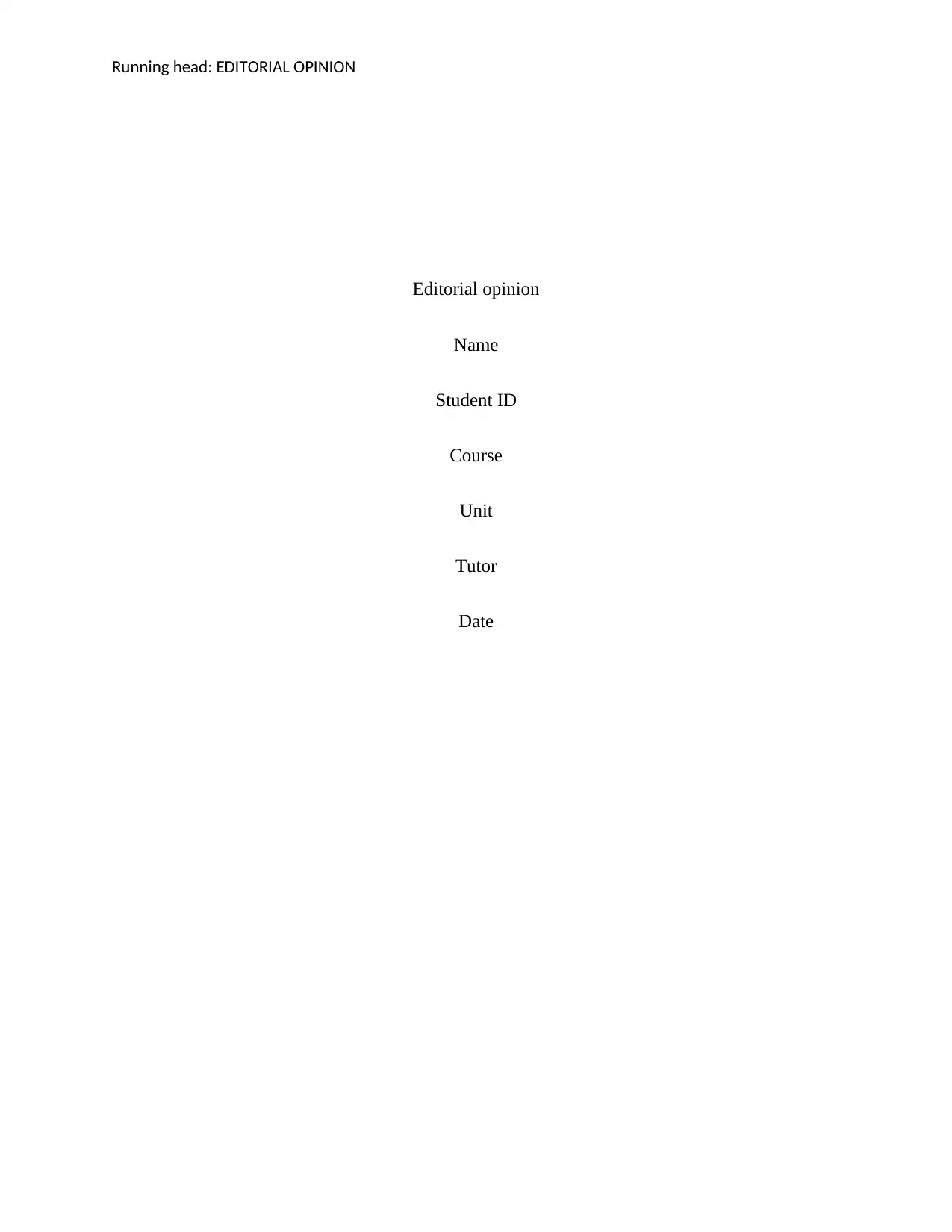
Running head: EDITORIAL OPINION
Editorial opinion
Name
Student ID
Course
Unit
Tutor
Date
Editorial opinion
Name
Student ID
Course
Unit
Tutor
Date
Paraphrase This Document
Need a fresh take? Get an instant paraphrase of this document with our AI Paraphraser
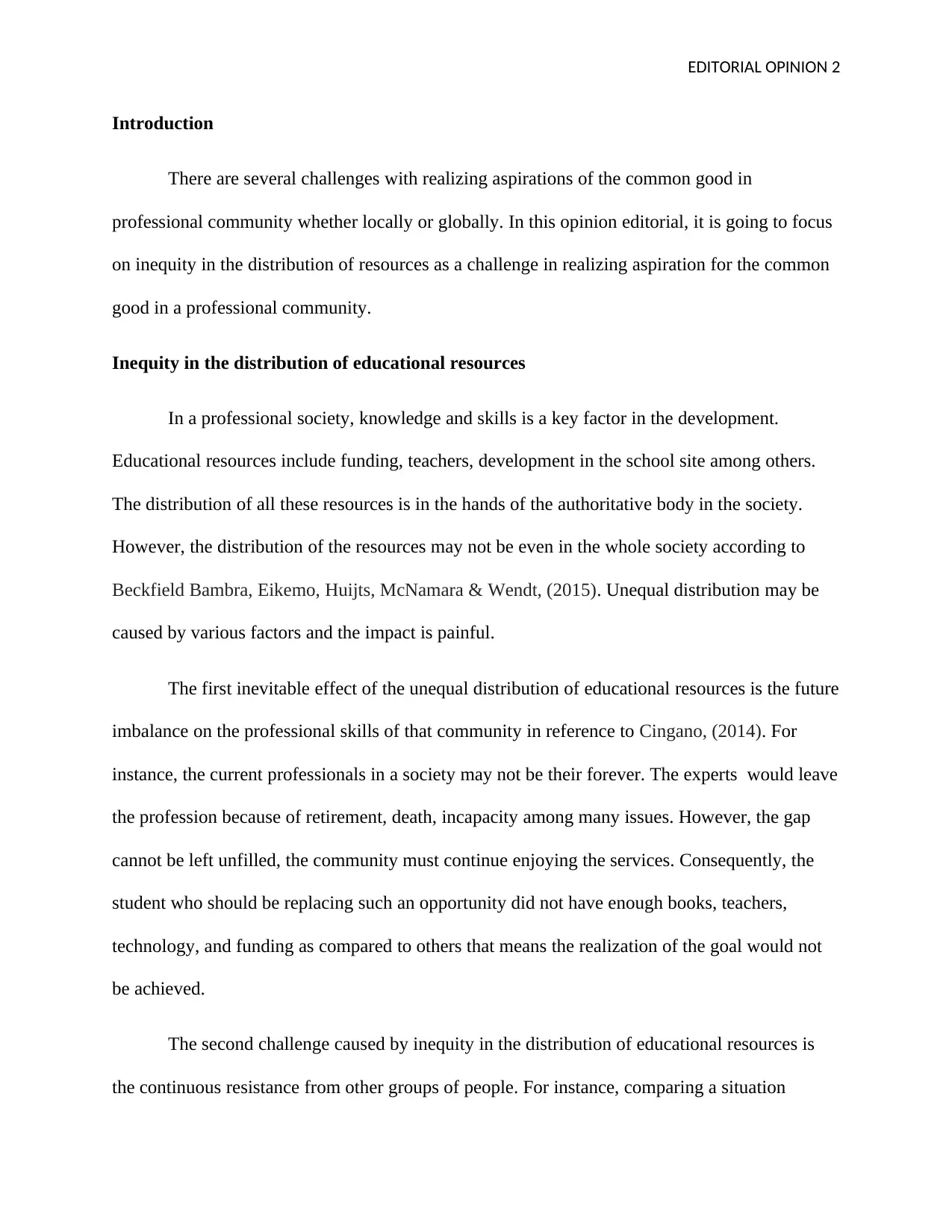
EDITORIAL OPINION 2
Introduction
There are several challenges with realizing aspirations of the common good in
professional community whether locally or globally. In this opinion editorial, it is going to focus
on inequity in the distribution of resources as a challenge in realizing aspiration for the common
good in a professional community.
Inequity in the distribution of educational resources
In a professional society, knowledge and skills is a key factor in the development.
Educational resources include funding, teachers, development in the school site among others.
The distribution of all these resources is in the hands of the authoritative body in the society.
However, the distribution of the resources may not be even in the whole society according to
Beckfield Bambra, Eikemo, Huijts, McNamara & Wendt, (2015). Unequal distribution may be
caused by various factors and the impact is painful.
The first inevitable effect of the unequal distribution of educational resources is the future
imbalance on the professional skills of that community in reference to Cingano, (2014). For
instance, the current professionals in a society may not be their forever. The experts would leave
the profession because of retirement, death, incapacity among many issues. However, the gap
cannot be left unfilled, the community must continue enjoying the services. Consequently, the
student who should be replacing such an opportunity did not have enough books, teachers,
technology, and funding as compared to others that means the realization of the goal would not
be achieved.
The second challenge caused by inequity in the distribution of educational resources is
the continuous resistance from other groups of people. For instance, comparing a situation
Introduction
There are several challenges with realizing aspirations of the common good in
professional community whether locally or globally. In this opinion editorial, it is going to focus
on inequity in the distribution of resources as a challenge in realizing aspiration for the common
good in a professional community.
Inequity in the distribution of educational resources
In a professional society, knowledge and skills is a key factor in the development.
Educational resources include funding, teachers, development in the school site among others.
The distribution of all these resources is in the hands of the authoritative body in the society.
However, the distribution of the resources may not be even in the whole society according to
Beckfield Bambra, Eikemo, Huijts, McNamara & Wendt, (2015). Unequal distribution may be
caused by various factors and the impact is painful.
The first inevitable effect of the unequal distribution of educational resources is the future
imbalance on the professional skills of that community in reference to Cingano, (2014). For
instance, the current professionals in a society may not be their forever. The experts would leave
the profession because of retirement, death, incapacity among many issues. However, the gap
cannot be left unfilled, the community must continue enjoying the services. Consequently, the
student who should be replacing such an opportunity did not have enough books, teachers,
technology, and funding as compared to others that means the realization of the goal would not
be achieved.
The second challenge caused by inequity in the distribution of educational resources is
the continuous resistance from other groups of people. For instance, comparing a situation
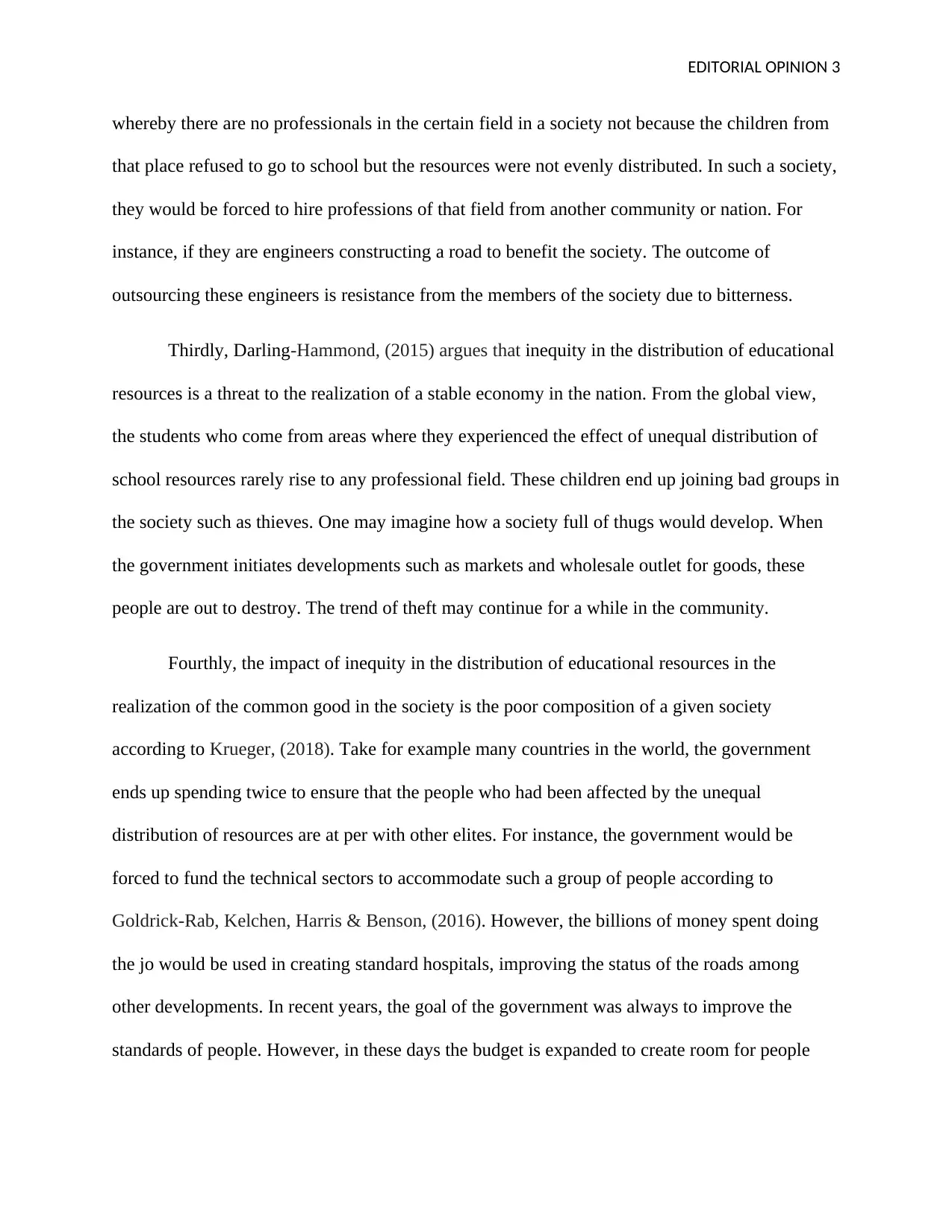
EDITORIAL OPINION 3
whereby there are no professionals in the certain field in a society not because the children from
that place refused to go to school but the resources were not evenly distributed. In such a society,
they would be forced to hire professions of that field from another community or nation. For
instance, if they are engineers constructing a road to benefit the society. The outcome of
outsourcing these engineers is resistance from the members of the society due to bitterness.
Thirdly, Darling-Hammond, (2015) argues that inequity in the distribution of educational
resources is a threat to the realization of a stable economy in the nation. From the global view,
the students who come from areas where they experienced the effect of unequal distribution of
school resources rarely rise to any professional field. These children end up joining bad groups in
the society such as thieves. One may imagine how a society full of thugs would develop. When
the government initiates developments such as markets and wholesale outlet for goods, these
people are out to destroy. The trend of theft may continue for a while in the community.
Fourthly, the impact of inequity in the distribution of educational resources in the
realization of the common good in the society is the poor composition of a given society
according to Krueger, (2018). Take for example many countries in the world, the government
ends up spending twice to ensure that the people who had been affected by the unequal
distribution of resources are at per with other elites. For instance, the government would be
forced to fund the technical sectors to accommodate such a group of people according to
Goldrick-Rab, Kelchen, Harris & Benson, (2016). However, the billions of money spent doing
the jo would be used in creating standard hospitals, improving the status of the roads among
other developments. In recent years, the goal of the government was always to improve the
standards of people. However, in these days the budget is expanded to create room for people
whereby there are no professionals in the certain field in a society not because the children from
that place refused to go to school but the resources were not evenly distributed. In such a society,
they would be forced to hire professions of that field from another community or nation. For
instance, if they are engineers constructing a road to benefit the society. The outcome of
outsourcing these engineers is resistance from the members of the society due to bitterness.
Thirdly, Darling-Hammond, (2015) argues that inequity in the distribution of educational
resources is a threat to the realization of a stable economy in the nation. From the global view,
the students who come from areas where they experienced the effect of unequal distribution of
school resources rarely rise to any professional field. These children end up joining bad groups in
the society such as thieves. One may imagine how a society full of thugs would develop. When
the government initiates developments such as markets and wholesale outlet for goods, these
people are out to destroy. The trend of theft may continue for a while in the community.
Fourthly, the impact of inequity in the distribution of educational resources in the
realization of the common good in the society is the poor composition of a given society
according to Krueger, (2018). Take for example many countries in the world, the government
ends up spending twice to ensure that the people who had been affected by the unequal
distribution of resources are at per with other elites. For instance, the government would be
forced to fund the technical sectors to accommodate such a group of people according to
Goldrick-Rab, Kelchen, Harris & Benson, (2016). However, the billions of money spent doing
the jo would be used in creating standard hospitals, improving the status of the roads among
other developments. In recent years, the goal of the government was always to improve the
standards of people. However, in these days the budget is expanded to create room for people
⊘ This is a preview!⊘
Do you want full access?
Subscribe today to unlock all pages.

Trusted by 1+ million students worldwide
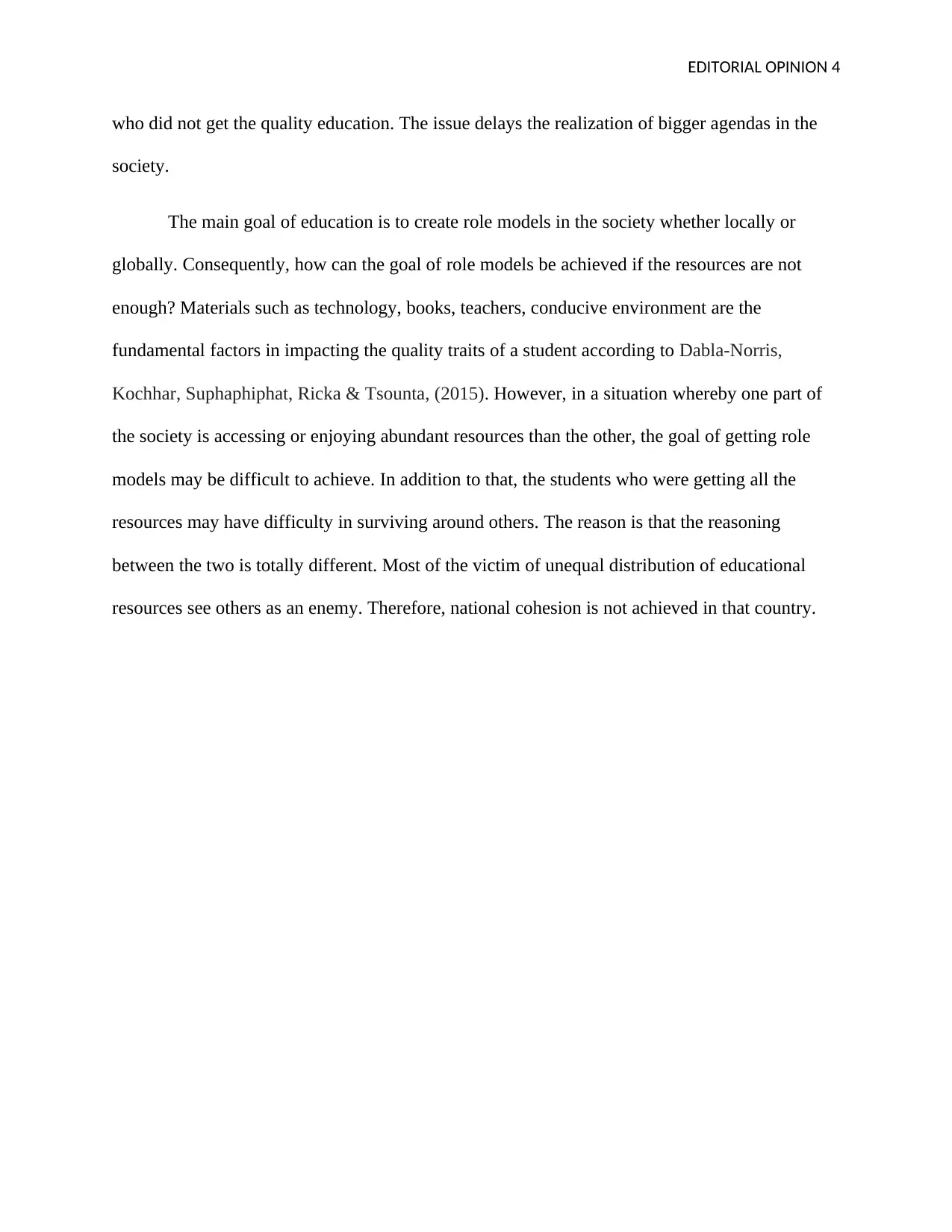
EDITORIAL OPINION 4
who did not get the quality education. The issue delays the realization of bigger agendas in the
society.
The main goal of education is to create role models in the society whether locally or
globally. Consequently, how can the goal of role models be achieved if the resources are not
enough? Materials such as technology, books, teachers, conducive environment are the
fundamental factors in impacting the quality traits of a student according to Dabla-Norris,
Kochhar, Suphaphiphat, Ricka & Tsounta, (2015). However, in a situation whereby one part of
the society is accessing or enjoying abundant resources than the other, the goal of getting role
models may be difficult to achieve. In addition to that, the students who were getting all the
resources may have difficulty in surviving around others. The reason is that the reasoning
between the two is totally different. Most of the victim of unequal distribution of educational
resources see others as an enemy. Therefore, national cohesion is not achieved in that country.
who did not get the quality education. The issue delays the realization of bigger agendas in the
society.
The main goal of education is to create role models in the society whether locally or
globally. Consequently, how can the goal of role models be achieved if the resources are not
enough? Materials such as technology, books, teachers, conducive environment are the
fundamental factors in impacting the quality traits of a student according to Dabla-Norris,
Kochhar, Suphaphiphat, Ricka & Tsounta, (2015). However, in a situation whereby one part of
the society is accessing or enjoying abundant resources than the other, the goal of getting role
models may be difficult to achieve. In addition to that, the students who were getting all the
resources may have difficulty in surviving around others. The reason is that the reasoning
between the two is totally different. Most of the victim of unequal distribution of educational
resources see others as an enemy. Therefore, national cohesion is not achieved in that country.
Paraphrase This Document
Need a fresh take? Get an instant paraphrase of this document with our AI Paraphraser
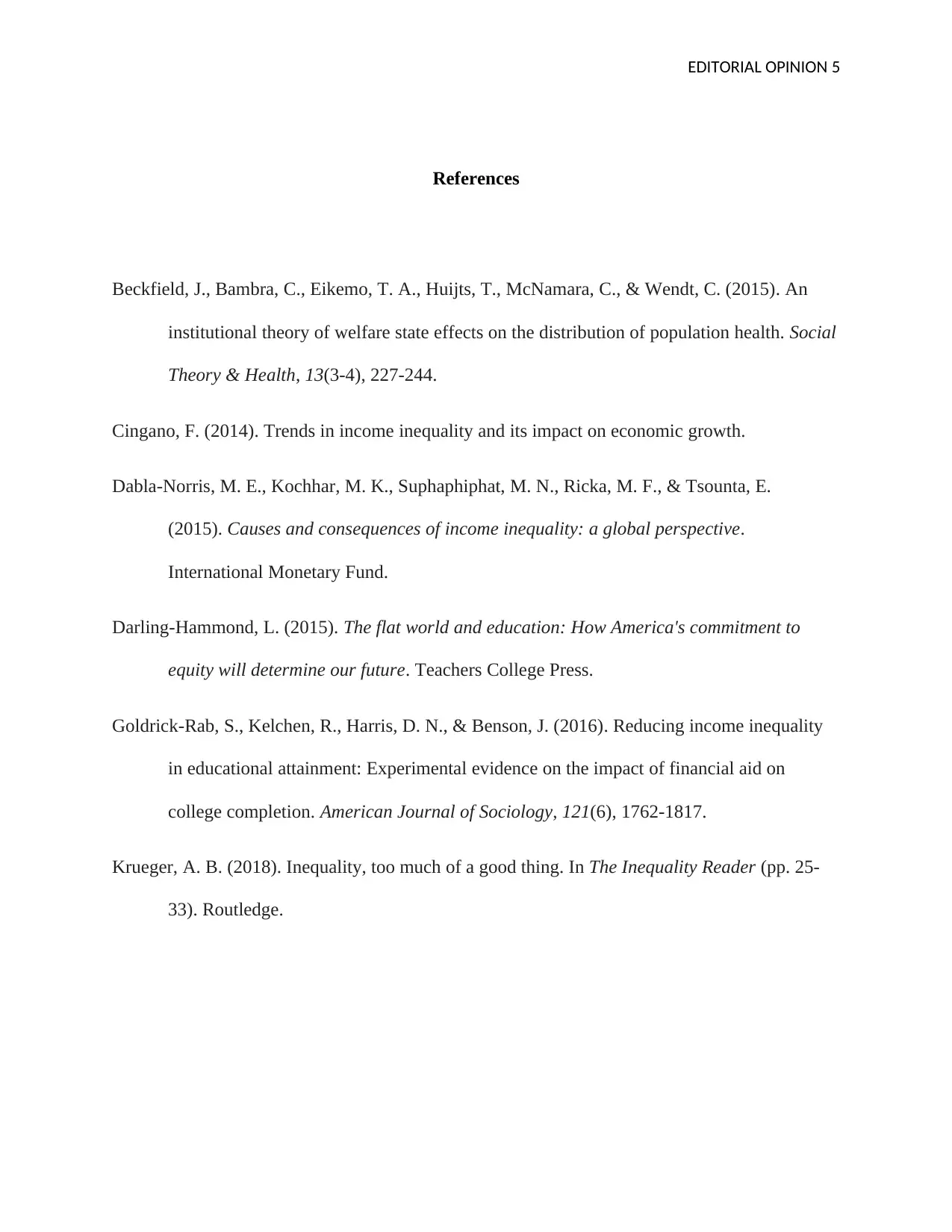
EDITORIAL OPINION 5
References
Beckfield, J., Bambra, C., Eikemo, T. A., Huijts, T., McNamara, C., & Wendt, C. (2015). An
institutional theory of welfare state effects on the distribution of population health. Social
Theory & Health, 13(3-4), 227-244.
Cingano, F. (2014). Trends in income inequality and its impact on economic growth.
Dabla-Norris, M. E., Kochhar, M. K., Suphaphiphat, M. N., Ricka, M. F., & Tsounta, E.
(2015). Causes and consequences of income inequality: a global perspective.
International Monetary Fund.
Darling-Hammond, L. (2015). The flat world and education: How America's commitment to
equity will determine our future. Teachers College Press.
Goldrick-Rab, S., Kelchen, R., Harris, D. N., & Benson, J. (2016). Reducing income inequality
in educational attainment: Experimental evidence on the impact of financial aid on
college completion. American Journal of Sociology, 121(6), 1762-1817.
Krueger, A. B. (2018). Inequality, too much of a good thing. In The Inequality Reader (pp. 25-
33). Routledge.
References
Beckfield, J., Bambra, C., Eikemo, T. A., Huijts, T., McNamara, C., & Wendt, C. (2015). An
institutional theory of welfare state effects on the distribution of population health. Social
Theory & Health, 13(3-4), 227-244.
Cingano, F. (2014). Trends in income inequality and its impact on economic growth.
Dabla-Norris, M. E., Kochhar, M. K., Suphaphiphat, M. N., Ricka, M. F., & Tsounta, E.
(2015). Causes and consequences of income inequality: a global perspective.
International Monetary Fund.
Darling-Hammond, L. (2015). The flat world and education: How America's commitment to
equity will determine our future. Teachers College Press.
Goldrick-Rab, S., Kelchen, R., Harris, D. N., & Benson, J. (2016). Reducing income inequality
in educational attainment: Experimental evidence on the impact of financial aid on
college completion. American Journal of Sociology, 121(6), 1762-1817.
Krueger, A. B. (2018). Inequality, too much of a good thing. In The Inequality Reader (pp. 25-
33). Routledge.
1 out of 5
Related Documents
Your All-in-One AI-Powered Toolkit for Academic Success.
+13062052269
info@desklib.com
Available 24*7 on WhatsApp / Email
![[object Object]](/_next/static/media/star-bottom.7253800d.svg)
Unlock your academic potential
Copyright © 2020–2025 A2Z Services. All Rights Reserved. Developed and managed by ZUCOL.





